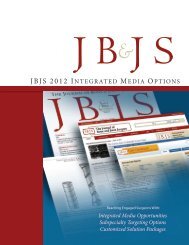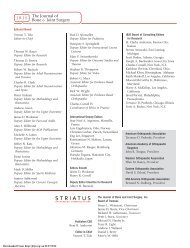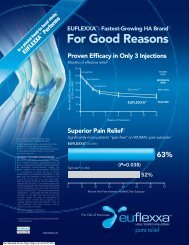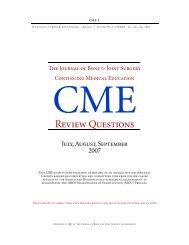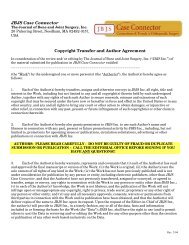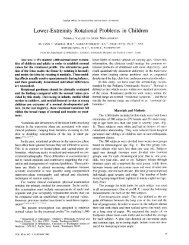Primary Repair of Flexor Tendons - The Journal of Bone & Joint ...
Primary Repair of Flexor Tendons - The Journal of Bone & Joint ...
Primary Repair of Flexor Tendons - The Journal of Bone & Joint ...
You also want an ePaper? Increase the reach of your titles
YUMPU automatically turns print PDFs into web optimized ePapers that Google loves.
<strong>Primary</strong> <strong>Repair</strong> <strong>of</strong> <strong>Flexor</strong> <strong>Tendons</strong><br />
BY CLAUDE E. VERDAN, M.D., LAUSANNE, sw’ITzERLAND<br />
Among some <strong>of</strong> the difficult problems still to be solved mi hand surgery,<br />
repair <strong>of</strong> flexor tendons in the digital sheath is not the least.<br />
It is generally agreed that inn a single fresh cut <strong>of</strong> the flexor pr<strong>of</strong>undus between<br />
the distal imisertion and the middle third <strong>of</strong> the middle phalanx, primary<br />
suture can give good results (Figs. 1-A through 2-C). It. is quite differemit, however,<br />
whemi the w’ound is located more proximally and both tendons are cut. Most<br />
authors say it is wise not to undertake immediate tendon repair when both flexor<br />
tendomis are divided in Bunnell’s no man’s land. Treatment. is limited to closing<br />
FIG. 1-A Flo. 1-B<br />
Result <strong>of</strong> I)rinn:try’ suture <strong>of</strong> the flexor l)OlliciS bingos, severed in the interphalanigeal fold.<br />
the w’ound, preceded by ecomnomnical excision <strong>of</strong> the wound edges, it the’ are<br />
contused. Secondary tendomi repair is postponed for two or three w’eeks. After<br />
this interval, excision <strong>of</strong> the sublimnis is recommemided, followed by a long tendon<br />
graft <strong>of</strong> the pr<strong>of</strong>undus, extemiding from the distal attachmemnt <strong>of</strong> this temidoni up to<br />
the proximal half <strong>of</strong> the palm (Figs. 3-A and 3-B).<br />
According to my ow’n experiemice, this operation is not only one <strong>of</strong> the niost<br />
difficult undertakimigs inn reparative surgery but also omie which gives the most uncertain<br />
results. It is known that these results depemnd on the select.iomn <strong>of</strong> cases<br />
for the operatiomi. A badly performed or unsuccessful primary repair can, <strong>of</strong><br />
course, jeopardize the success <strong>of</strong> a secondary graft; but it must also be recalled<br />
that division <strong>of</strong> the two neurovascular bundles <strong>of</strong> a finger will cause trophic disorders,<br />
amid these make secomidary repair very difficult.<br />
Skill, patience, and painstakimig attention to details are required <strong>of</strong> the<br />
surgeomi.<br />
<strong>The</strong> good results obtained by Boyes’ amid Pulvertaft8 (70 to 80 per cent<br />
success) are not. always attained. I, personally, durimig the past seven years have<br />
performed about sixty temidon-grafting procedures. I must admit, however, that<br />
niy percentage <strong>of</strong> good reults is miot so high.<br />
Without giving details comicermnimng the technical difficulties that may impair<br />
the final result, I would say that, at present, a temidomi graft is still the exclusive<br />
job <strong>of</strong> the specialist or, at least, the specially trained surgeon. Usually tinese<br />
* Read at the Annual Meeting <strong>of</strong> the American Society for Surgery <strong>of</strong> the IIanl(l, Chicago,<br />
illinois, January 23, 1959.<br />
VOl.. 42-A, NO. 4. JUNE 1960 617
648 (‘. E. VERDAN<br />
}I(. 2-C<br />
Figs. 2-A, 2-B, Lli(I 2-C : <strong>The</strong> flexor l)r<strong>of</strong>umidus<br />
alone severed in the IUi(Idl(’ thir(l <strong>of</strong> the<br />
middli’ phalanx <strong>of</strong> the iln(1eX finger. Omily<br />
PrimarY tefl(lOIi r(’pair Was l)(m’fornn(’(I (no<br />
tUIiol\’Sis).<br />
Figs. 3-. an(1 3-13 : (‘mit <strong>of</strong> both, flexor t(’n(lonls<br />
in mo mami’s lanid <strong>of</strong> the little finger. Photographs<br />
show the result five months aft’r ten(lomi-graf ting.<br />
JoImtNAL OF BONE ANI) JOINT sI’IWERY
VOl.. 42-., NO. 4. JUNm: 1960<br />
I’RlM;mv REPAIR OF FLEXOR TENI)ONS 649<br />
FIG. 4-A Fmo. 4-B<br />
Figs. 4-A, 4-B, amid 4-C: Cit <strong>of</strong> both flexor<br />
t(nldonis imi the index fimnger, <strong>of</strong> the flexor lr<strong>of</strong>mndus<br />
and one-half <strong>of</strong> the subliiiiis in the long<br />
finger, an(l <strong>of</strong> one-half the pr<strong>of</strong>imnidus in the ring<br />
finnger. Only l)riniarY repair was l)erforlned ; the<br />
Patient. (li(l not wishi a secomRlarv t.(’flolVSiS.<br />
sum’geonns a.re not. tine onnes who see the<br />
Ptttiemnts inn the eniergemi(’y m’oomii. It is,<br />
minost. fiequeiit ly, tine gemienal pm’a(’t itionel’<br />
or the imnt.em’ni. l.mi(lem these cii’-<br />
(‘umiistannces, it is justified ali(l wise riot<br />
to pem’foi’ni pm’innary repan’.<br />
Iiowe\’eI, I would like to show that<br />
the surgeomi is’ho is trainne(l to perfoi’nn a<br />
successful giaft <strong>of</strong> the flexom temidomis is<br />
also cttpal)le <strong>of</strong> perfom’nnimig a su(’(’essful<br />
PI’imnial’y<br />
fresh an(i<br />
tendon<br />
cleanly<br />
m’epaim’-if<br />
cut-without<br />
the vounicl<br />
crushing<br />
is<br />
FIG. 4-C<br />
the tissues, if he applies somne sound techmiical mules.<br />
Iii miny 1)00k Chirurgie R#{233}paratrice et Fonctionnelle (ICS <strong>Tendons</strong> (IC La ibm<br />
\Vlii(’li I wrote inn 1951, I t’anne to tine conclusiomi, after givimig all the I’easonis fon’<br />
amn(l agaimns’t it, that priniam’y iepaii’ <strong>of</strong> the flexor temidomis is nnot on1’ ad’isable<br />
lilt also possible, riot omily imi the al-eas kmiowmi to be favorable for lnimiian’’ m’epaim-,<br />
l)Ut. also in the oste<strong>of</strong>ibm’ou.s tunnel <strong>of</strong> the tingem’. Ilowevem’, this l)m’imiiamy m’epaim’ minust<br />
sol’e the miie(’hamii(’al amid physiological pn’oblemii <strong>of</strong> glidimng.<br />
I (l(SCmil)(!(l iii ny 1)00k a miew t.ecliniique I applied \\‘hi(’hi utilizes staimilesssteel<br />
tm’annstixion pins to hold the ends <strong>of</strong> the lacem’ated tenidoni inn (‘omita(’t witin<br />
omit’ lmiOtliem’ mi ii part <strong>of</strong> the sheath that is imnta(’t, without pla(’imig amiy sutures iii<br />
the tenidonn ends.<br />
Although somnie good m’esults have beemi obtainie(l with this mniethod (Figs. 4-<br />
A, 4-13, ami(l 4-C), I have now (le(’ided that this is not the 1)est possible solution to<br />
the difficult l)m’Ol)lemii \Vhii(’hi Buniniell, i\Iasoni a.mi(I Allen, loch, rimnd others have<br />
tm’ie(l to solve.<br />
I ha\e miov nnnodified this (inst te(’hnii(luc amid hna\’ use(l SVSt(’miiaticahlV a<br />
se(’om i(l niet 110(1 <strong>of</strong> I )Io(’ ked simt times, vhi i(’h i ni ci t1(leS m’ese(’t i( )n i (if t Inc shieat In ann (1<br />
gi’eatem’ l)1’((’i5)1i in the aligminiemit <strong>of</strong> tine (‘lit emitis.<br />
(‘tually, mi the first nietliod, the enids <strong>of</strong> the flexor i)n’0tlmmidLIS \vcn’e sonii(’-<br />
I iiiies too loose iniside the sheath fn’oni \vhi(’hi the sui)himiiis had b)e(’ni m’emnoved.<br />
\Vithini the inittt(’t sheath the tendon emids could have sonic l)laY amid thins, durimig<br />
hiealimng, a bm’iish <strong>of</strong> iegenierat.imng “umnsa.t.isfied’’ fibers was for-nied. Since tine sheath
650 C. E. VERDAN<br />
participates imi the healing <strong>of</strong> the tendomi, the healed tendon did not glide as<br />
well as one might. hope for.<br />
<strong>The</strong>refore, I miow resect about omie inch <strong>of</strong> the sheath at the site <strong>of</strong> the suture,<br />
as Mason did, amid suture the emids <strong>of</strong> the tenndomn together very accurately w’ith<br />
four small epitendimious stitches at the four cardimial poimnt.s, usimig fimne 000000<br />
arterial silk, as is’ domie for a nerve suture.<br />
This ac(’urate but fragile repair will mnot resist the tractioni <strong>of</strong> the muscles.<br />
however, protectiomi is achieved by imnimnobilizing the tendon with two stainless-<br />
steel pimis, a procedure which is much easier than Bunnell’s “sut.um’e at a dist.amnce”,<br />
usimng a pull-out. nn’ire.<br />
<strong>The</strong> pimi,s that. pass through the skin, the sheath, amid the tendon are placed<br />
t.ramisverselv ; one distal and omie proximal to the suture.<br />
FIG. 5<br />
Technique <strong>of</strong> <strong>Primary</strong> blocked suture <strong>of</strong> the flexor pr<strong>of</strong>undus when both flexor temidons are<br />
severed in no man’s land; resection <strong>of</strong> the flexor suI)limis and the digital sheath.<br />
TECHNIQUE<br />
After ecomnomical excisioni <strong>of</strong> the margimis <strong>of</strong> the transverse w’ound caused by<br />
the accident, the incision for the repair <strong>of</strong> the tendon is made, usimig a classic<br />
mid-lateral opemnimig, without much regard for the woumid produced by the trauma.<br />
<strong>The</strong> approach to the sheath goes dorsal to the neurovascular pedicle ; the nerve, if<br />
severed, is repaired only at the emid <strong>of</strong> the operatiomi.<br />
First the sublimis is resected. For this procedure, the lesion <strong>of</strong> the tendon<br />
sheath caused by the accidemit generally is too small. This opemnimig is therefore<br />
enlarged amid used for the extractiomi amid resection <strong>of</strong> the two small distal slips.<br />
<strong>The</strong> proxinial emid <strong>of</strong> the flexor sublimis tendon, which has retracted into the<br />
palm, is located through a short transverse incision inn the distal palmar crease.<br />
It is divided as far proximally as possible. Only the pr<strong>of</strong>umidus is replaced iii<br />
the sheath amid l)Ilsiie(1 innto the (ligital (‘amial.<br />
At t.hnLs timne it. is inniportanit to place tine fInger mi the proper semniflexed<br />
1)OsitiOni inn nvhichi it will he immniohiilized rtmi(1 inn which the pins will be inserted<br />
before tine tenidomi iss’utured. In doing this one lutist look for tine ‘‘position <strong>of</strong> rest’’,<br />
which cinamiges \n.ith:flexionior extenision <strong>of</strong> tine wrist. With the finnger in this positiomi<br />
the lacerated ends <strong>of</strong> the tenidomi will proh)ably have no relationrt,o the acci-<br />
THE JOURNAL. OF OONE AND JOINT SURGERY
FIG. 6-A FIG. 6-B<br />
Figs. 6-A, 6-B, amid 6-C: Both flexor tendomns<br />
were severed in no mamn’s land <strong>of</strong> the long<br />
finger. mi the index finger, there was a cut <strong>of</strong><br />
the flexor l)r<strong>of</strong>ufldus between the proximal and<br />
nniiddle thirds <strong>of</strong> the middle phalanx. Figs. 6-B<br />
atiti 6-C show the result seven months after<br />
Primar)’ repair.<br />
Figs. 7-A 1.fl(l 7-B : Both flexor tenidons wt’r(’<br />
severed iii the middle thuird <strong>of</strong> the proximal<br />
l)halalix <strong>of</strong> the ring finger. <strong>The</strong> photographs<br />
show the result after primary suture <strong>of</strong> the<br />
l)r<strong>of</strong>umidmms and omne collateral mierve.<br />
VOL. 42-A, NO. 4, JUNE 1960<br />
PRIMARY REPAIR OF FLEXOR TENDONS 651<br />
FIG. 6-C<br />
FIG. 7-A Fmo. 7-B<br />
dental openimig in the sheath. Conisequemitly, this opemning in the sheath is disregarded<br />
from this point on.<br />
Over the juncture <strong>of</strong> the two ends <strong>of</strong> the tendomi, the sheath is opemned or the<br />
existing openimig is enlarged so that the sheath is excised over a distance <strong>of</strong> about<br />
onie inch. This is dome misuch a way that the futuie scar at tine site <strong>of</strong> tendomi repair<br />
will slide freely inn both directions without contacting the sheath. <strong>The</strong> amount <strong>of</strong>
652 C. E. VERDAN<br />
FIG. S-.<br />
Fa;. 8-C<br />
Figs. 8-A, 8-B, :01(1 8-C: Cut <strong>of</strong> both flexors in the distal third <strong>of</strong> the first. Phalanx <strong>of</strong> the ring<br />
finger. <strong>Primary</strong> l)lo(’k(’d suture <strong>of</strong> tine flexor pr<strong>of</strong>immndims was l)(’rformnn(’d. Figs. S-B anid 8-C show the<br />
functional result. at follow-up t no ‘‘ars after operation.<br />
sheath resected is detem’niiimied by estimniat.inig the physiologica.l glidimng amplitude<br />
at this level (Fig. 5).<br />
This nieamns that niost frequemitly the suture line will not be at the same location<br />
as the origimial lesiomn. If the finger i’as extended at the time <strong>of</strong> injury-a<br />
very rare occ’um’i’enice-tiie suture limie will be proximal to the site <strong>of</strong> injury. If, on<br />
the comit.ram’y, the fimngem- was flexed at the tinie <strong>of</strong> imnjury-which quite frequently<br />
happens i)eeause <strong>of</strong> au imnstimictive protective m’eflex which comes into play at the<br />
tinie <strong>of</strong> injum’y-t.he sutiim’e limie n’ill lie mneai’ the distal emid <strong>of</strong> the huddle phalanx.<br />
This is very iminportant because if the temidomi scar does becoiiie fixed to the middle<br />
phalamix, the poimnt <strong>of</strong> attachment. will be so far distal that the tendomn will preserve<br />
enough excumsiomn within the fimiger to pi-oduce flexiomi <strong>of</strong> the proximal int.erphalan-<br />
geal joint-a inotiomi <strong>of</strong> capital imiipoi-tance fon’ fumiction <strong>of</strong> the digit..<br />
Furtherniom’e, by excising the sheath inn an imitact zone, the tendon scam’<br />
vil1 be surrounide(l by sul)cutaneous fat and not by a fibrous tunnel <strong>of</strong> fixed diam-<br />
THE JOURNAL OF BONE AND JOINT SURGERY
Vol.. 42-A. NO. .1, Jt’NE 1960<br />
I’1tIM.RY IIEI’.i.IiI OF FLEXOR TENDONS 653<br />
FIG. 9-A Fli;.0-B<br />
Figs. 9-A. 9-B, amid 9-C: Tennolysis. (ut <strong>of</strong><br />
hoth flexors at the level <strong>of</strong> the l)roXinial inter-<br />
)halamigea1 joimit <strong>of</strong> tin(’ in(l(’N finger. Because<br />
t lie priniary r(’pair failed, t(’mnolysis was p’rfon’nii(’(l<br />
t\v() ami(l onie-hialf nionthis laten’.<br />
(‘icr. <strong>The</strong> m’enflriimi(ler <strong>of</strong> this sheath<br />
suffices to pm’evemnt dislocation <strong>of</strong> the<br />
tenidomi, j tist. as it does inn the t.echmiique<br />
<strong>of</strong> tendoni-graftinig, inn which mesN’tiomn<br />
<strong>of</strong> the sheath is still mimic extemisive.<br />
<strong>The</strong> finigem’ is iminniol)ilized mi a rest-<br />
inig l)Ositioni i)y a pad(Ied doi’sal sphimit.<br />
If tine flexon tenndomi <strong>of</strong> the thnimnil) is<br />
l)eing repaim-ed a (‘Iist should be used.<br />
I have<br />
‘ -<br />
com’tieoids<br />
not V(t. \‘emntllm’e(l to<br />
.<br />
aftem Ol)eratiomi.<br />
use<br />
Fr;. 9-C<br />
After a iinaximiiunn <strong>of</strong> thnmee weeks, the splint amid tine hiockimig l)ilis are re-<br />
nniove(l. Svst.emniatie active exem(’ises, inicludimig )lmshimng oni the palnmam’ side <strong>of</strong> the<br />
l)halallx, rime them stamted cautiously amid imn(’m’eased gl-a(lually to niobihize the terndomi.<br />
Somnietinnes, gentle passive mnioi)ihizatiomi dum’inng the foum’t.h iveek aft.en opera-<br />
tiomn w’ill m’upt time fm’eshn rulhnesiomis, amid this mnnay imnipmove tine enid n-esiilt (‘omisi(ler-<br />
InI)ly.<br />
Eight to ten (lays aft.em’ tine begiiimiimig <strong>of</strong> mnobihizat.iomi <strong>of</strong> tine digit. the patiemit<br />
is pernuit.ted to resume pai-t.ially his former activities.<br />
rfiius, tine timine <strong>of</strong> inmnnoi)ihizatiomi amid the pem’iO(l <strong>of</strong> eim’ly m’ehabilitat.iomi anniounit.<br />
to fioiii foui to five weeks <strong>of</strong> disability (Figs. 6-A t.hi’oughn 8-C).<br />
Ten ol!Jsis after Un s uccessful Pri?nar!J “ mire<br />
It will lie niec’essan’v to j)(’mfoi’mii a secondam’y temnolysis : ( 1 ) if after three inionithis<br />
t.h(’n’e has beemi ho funictiomial imiipmo\’emiiemit amid tine active nnotiomn n.emnLti!is mnniichn<br />
less than the l)assiVe mniovememnt inn tine joimits <strong>of</strong> the involved fimiger : (2) if th(<br />
l)ati9it. thimnks the result. is not. suffieiemnt. for the mieeds <strong>of</strong> his pr<strong>of</strong>essionial task<br />
on- (3) if thiel(’ is (‘omnplete a(lhnesiomn <strong>of</strong> the temi(Ion , as o(’cIini’e(l inn 25 to 30 Pel’ (‘emit<br />
<strong>of</strong> the pat.iennts.<br />
‘1ii openat.iomn i’e(ltiim’es niot only tine fneeing <strong>of</strong> adinesiomis i)l.it. <strong>of</strong>temi a ri’-<br />
sectiomi <strong>of</strong> tiie temi(l<strong>of</strong>l -heatin, amid <strong>of</strong> tue mnom’mnial pulleys as vehl, inn (higits inn winicin<br />
adhesionns <strong>of</strong>’ tine tendomi (‘over a lomig dist.anice. As mi the f’mi-st stel) <strong>of</strong> a temndoni<br />
graft, only a shomt fibrous m-imig is left as a pulley on each phalanx. Hemiio’al <strong>of</strong><br />
the sheath is (‘onltinnue(l umntil traction on the flexor pr<strong>of</strong>umndus at tine tipper inalf<br />
<strong>of</strong> tine pain causes complete, effortless flexion <strong>of</strong> the fimnger. Elastic i)anidages
654 C. E. VERDAN<br />
FIG. 10-C<br />
an umisuecessful temndonn graft if<br />
the graft.. For prinnary repair <strong>of</strong><br />
sufficiennt (Figs. 9-A tinrough 10-C).<br />
Figs. 10-A, 10-B, and 10-C: Tenolysis. Both flexor<br />
tendons <strong>of</strong> the long finger were severed at the metacarpophalangeal<br />
fold. Failure <strong>of</strong> primary simtmmre <strong>of</strong> the<br />
pr<strong>of</strong>undus and resection <strong>of</strong> the sublimis was followed by<br />
complete adhesions <strong>of</strong> the tendons. Normal ftmnct.ion was<br />
regained after tenolysis.<br />
are applied after operation , amid nioi)ilizat ionn<br />
is begun as soomi as the postoperative painn<br />
ns’ill allow’.<br />
Myfriend, .Jacques Michomi, fromin Xamncy,<br />
amid I demomnst.rated that seconidary tennolysis,<br />
the indications <strong>of</strong> w’hich are many , (‘am be<br />
particularly useful after au unsuccessful primary<br />
suture as well as after am unsuccessful<br />
tendomi graft. However, it is advisable to w’ait<br />
six months before performing a tenolysis for<br />
one w’ishes to avoid spomitaneous rupture <strong>of</strong><br />
flexor tendons a delay <strong>of</strong> three niomiths seemnis<br />
RESULTS<br />
Lesions <strong>of</strong> tine flexor temndomns in no main’s land are relatively rare. Although<br />
the hand surgeonn is seldom called on to repair fresh lacerations, he is vemy <strong>of</strong>ten<br />
requested to perform grafts on patients sent to him from all over the country.<br />
<strong>The</strong>se Se(’omnd operatiomns, <strong>of</strong> course, must be performed accordimig to the prescribed<br />
prograni for t enndomn-graft.ing.<br />
Since 1952, end results after primary suture <strong>of</strong> flexor t.endomis inn nio mann’s<br />
laud, perfornied accordimng to the technique described, are available for five thumb<br />
flexor temndons amid fourteen flexor tendons in the four other digits, a total <strong>of</strong> nineteem<br />
cases. <strong>The</strong> results’ obtainied iii three other patiemits nn’hose digits are still umnder<br />
tm’eatnient are too re(’enit. to be considered.<br />
Imi tine t.hunibs tine aniplitude <strong>of</strong> active nnotiomi, measure(l at. tine innteipinalani-<br />
geal joint, m’aniged fn’onn 45 to 80 degrees.<br />
mi the lesser digits, temn <strong>of</strong> fourt.eemi Iinngem’s have a ramige <strong>of</strong> ru’tive mniotiomi<br />
betweenn 20 and 95 degrees foi’ tine proximnial interphalangeal joinit, amn(1 betweeni<br />
10 amnd 30 (legrees for the distal initerphalamngeal joint.. None <strong>of</strong> these t.emn fingers<br />
required additional intervention.<br />
<strong>The</strong>re were three failures due to complete adhesions <strong>of</strong> the tendon and one<br />
THI JOURNAL OF BONE AND JOINT SURGERY
PRIMARY REPAIR OF FLEXOR TENDONS 655<br />
partial failure due to flexion contracture <strong>of</strong> the proximal interphalangeal joint;<br />
these fingers required reoperation. In one <strong>of</strong> these fingers a temndomn graft was a<br />
failure. <strong>The</strong> other three were treated with temnolysis, resulting iii a functiomnal<br />
recovery which was almost normal in one amid perfect in amnother. In the third,<br />
complete flexion w’as regained but a new progressive linnitatiomn <strong>of</strong> extemnsioii was<br />
produced by flexion contracture <strong>of</strong> the proximal interphalangeal joint.<br />
I recently reoperated on this last-mentioned finger, resectimng the retracted<br />
mew sheath amid the volar ligament <strong>of</strong> the proximal interphalangeal joimit. Luckily,<br />
the final result, at the time <strong>of</strong> writing, is good, the patient having worn an elastic<br />
dorsal splint.<br />
Gemierally, results, as in the case <strong>of</strong> grafts, seem to depemid omi the trophic<br />
state <strong>of</strong> the finger, and, therefore, on the presence <strong>of</strong> concomitant laceration <strong>of</strong> the<br />
digital mierves. Possibly, the results also depend, to sonic extemnt, omi the integrity<br />
<strong>of</strong> the periosteal covering <strong>of</strong> the phalanx.<br />
It is worthy <strong>of</strong> note that even a poor result in the imidex finger can give useful<br />
fumnction since pinch between the thumb and index finger will be possible. <strong>The</strong><br />
absemice <strong>of</strong> complete flexion is a less severe handicap in the index finger than in the<br />
other three fingers, as was pointed out by Pulvertaft in connection with temndomn<br />
grafts. <strong>The</strong> same argument is applicable for primary sutures.<br />
Multiple Sections<br />
I believe that w’hemi the flexors <strong>of</strong> several fingers have been cut simultaneously,<br />
repair by a secondary graft becomes particularly difficult. To perform multiple<br />
tendon grafts at one operation is a very long and detailed procedure.<br />
<strong>The</strong> time required for the functional re-education will be longer, adhesions<br />
<strong>of</strong> grafts will be more difficult to liberate, and the patient’s period <strong>of</strong> incapacity<br />
will be longer.<br />
When the flexor tendons <strong>of</strong> several fingers have been severed, primary repair<br />
-a relatively short operation-seems all the more justified. Inn the hands <strong>of</strong> a<br />
specially trained surgeon primary repair does not endanger the future <strong>of</strong> the hanid<br />
and <strong>of</strong>fers the possibility <strong>of</strong> restoring adequate function by performing omnly a<br />
secondary localized tenolysis on one or more fingers or, if need be, a complete<br />
tenolysis. Moreover, after primary repair the possibility <strong>of</strong> doing a later graft still<br />
exists.<br />
If the patiemit can start working soon after the primary suture, dystrophic<br />
changes in the injured hand will be minimized. <strong>The</strong>se chamiges are so frequemnt amid<br />
sometimes so serious after the flexor tendons <strong>of</strong> several fingers have been severed,<br />
that one <strong>of</strong>ten hesitates to undertake the risk <strong>of</strong> a secondary tendon graft. In the<br />
meantime, the tendon sheaths contract and become obliterated, the articulatiomns<br />
become stiff, and success is jeopardized.<br />
CONCLUSIONS<br />
Although my series <strong>of</strong> nineteen cases <strong>of</strong> primary sutures and sixty tendomi<br />
grafts is a modest one, I believe, nonetheless, that it entitles me to state that<br />
primary repair <strong>of</strong> the flexor tendons in no man’s land, performed according to<br />
certain technical rules, is a valid operation for fresh, cleanly cut wounds.<br />
Results <strong>of</strong> primary repair appear to me, as far as quality is concerned, the<br />
same as, if not superior to, those obtained by tendon grafts.<br />
Regarding fresh simultaneous lacerations <strong>of</strong> the tendons <strong>of</strong> several digits, my<br />
preference for primary suture becomes imperative.<br />
SUMMARY<br />
<strong>The</strong> rule hitherto adopted that tendon grafts should be performed in preference<br />
to primary repair <strong>of</strong> tendons cut in Bunnell’s no man’s land is too rigorous.<br />
Delayed tendon-grafting is only justified for those physicians having no experience<br />
in hand surgery or when general or local conditions do not allow innmediate<br />
repair.<br />
VOL. 42-A, NO. 4, JUNE 1960
656 c. E. VERDAN<br />
For cleanly cut, fresh w’ounds, specialists capai)le <strong>of</strong> performinng temndomn grafts<br />
correctly, are a fortiori qualified to effect successful primary sutures. ‘rhe tech-<br />
mii(lue proposed comisists un excisimng the sublimis, suturing the pr<strong>of</strong>umndus accum’ateiy<br />
with fine epitendinous stitches, resecting the sheath inn the regiomi <strong>of</strong> the<br />
repair, amid immobilizing the emids <strong>of</strong> the tendon with two transverse stainlesssteel<br />
pius to prevemnt tensiomn omi the delicate suture himne, w’hich is (‘oniparal)le to<br />
that in a nerve suture.<br />
Should adhesions hinder gliding, a secondary temnolysis will pi-oduce functional<br />
results <strong>of</strong>ten better thami those obtained by tendon grafts.<br />
For multiple simultaneous flexor-temidomi lacerations iii several digits, primary<br />
repair is evemn more justified thamn for a tendon laceration imi one digit.<br />
REFERENCES<br />
1. BOYES, J. H. : <strong>Flexor</strong>-Tendon Grafts in the Fingers and Thumb. Ann Evaluatiomi <strong>of</strong> Lmnd Results.<br />
J. <strong>Bone</strong> and <strong>Joint</strong> Surg., 32-A: 489-499, July 1950.<br />
2. BOYES, J. H. : 1)iscussion. Le Sixi#{232}me Congr#{232}s Intenmnational de la Soci#{233}t#{233} Int.ernationale (1(’<br />
Chirurgie Orthop#{233}dique et de Traumatologie, Berne, Switzerland, 1954. Bruxelles, lmnnprimnerie<br />
Lichens, 1955.<br />
3. BUNNELL, STERLING: Surgery <strong>of</strong> the Hand. Ed. 3. Philadelphia, J. B. Lippincott Co., 1956.<br />
4. KOCH, S. L. : 1)ivisiomn <strong>of</strong> the <strong>Flexor</strong> <strong>Tendons</strong> withimn the 1)igital Sheath. Surg., (iymiec., amid<br />
Obstet., 78: 9-22, 1944.<br />
5. IASox, M. L. : <strong>Primary</strong> amid Secondary Tenndon Suture. A 1)iscussion <strong>of</strong> the Sigmnificamice<br />
<strong>of</strong> Technique in Tendon Surgery. Sung., Gynec., and Obstet., 70: 392-402, 1940.<br />
6. MASON, M. L., and ALLEN, H. S. : <strong>The</strong> Rate <strong>of</strong> Healing <strong>of</strong> <strong>Tendons</strong>. Ami Expenimelntal Study <strong>of</strong><br />
Tensile Strength. Ann. Sung., 113: 424-459, 1941.<br />
7. MASON, M. L., and SHEARON, C. G. : <strong>The</strong> Process <strong>of</strong> Temndomn <strong>Repair</strong>. An 1’x1)eninn(’nital Study<br />
<strong>of</strong> Tendon Suture and Tendon Graft. Arch. Sung., 25: 615-692, 1932.<br />
8. IULVERTAF’F, H. G. : <strong>Repair</strong> <strong>of</strong> Tendonn Injuries in the Hand. Annn. Roy. CoIl. Sung. Emigland,<br />
3: 3-14, 1948.<br />
9. PULVERTAFT, R. G. : <strong>Repair</strong> <strong>of</strong> Tendomi Injuries inn the Hamnd, with Special Reference to <strong>Flexor</strong><br />
Tendomns. Postgrad. Med., 8: 81-87, 1950.<br />
10. PL’LVERTAFT, H. G. : Experiences in Secondary <strong>Flexor</strong> Temidon Grafting in the Hand. Acta<br />
Orthop. Belgica, :Z4 (Supplementum 3): 62-74, 1958.<br />
1 1. RoBINS, R. H. C. : <strong>The</strong> <strong>Primary</strong> Reconstruction <strong>of</strong> the Imnjured Hand. Ann. Roy. CoIl. Sung.<br />
England, 14: 355-370, 1954.<br />
12. VERDAN, C. F:. : Chirurgie R#{233}paratnice ct Fomictionnelle des Tendomns (he itu Main. Paris, L’Expansion<br />
Scientifique Fran#{231}aisc, 1952.<br />
13. VERDAN, C. E. : La nparation immediate des tendons fl6chisseuns darns Ic canal digital. Acta<br />
Orthop. Belgica, 24 (Supplementum 3): 15-23, 1958.<br />
14. VERDAN, C. B., and MIcH0N, JACQUES: T#{233}nolyse des tcmndons flchisseurs (1(’s doigts. Animi.<br />
Chin. Plastiquc, 4: 283-296, 1956.<br />
1)ISCUSSION<br />
DR. MICIIAEL L. MASON, CuIcAGo, ILLINOIS: <strong>The</strong> only area <strong>of</strong> the hand where there is nnajor<br />
disagreement concerning primary tendon repair is in what has been euphemistically called mo man’s<br />
land, and I should like to confimne my few remarks to that phase <strong>of</strong> the problem. It was not too<br />
many years ago that the grafting <strong>of</strong> tendons in this area <strong>of</strong> the hand seemed to be am insurmountable<br />
problem and was undertaken with little assurance <strong>of</strong> success. In fact, the solution for the problem<br />
<strong>of</strong> a motionless fimiger was <strong>of</strong>ten amputation. Even today, temidon-grafting in the digits is undentaken<br />
omily when conditions are satisfactory and by surgeons well trained in the technique. Even<br />
so, tendon grafts in the digits are by no means 100 per cent successful and many iingenious measurennents<br />
are made to gauge the degree <strong>of</strong> return <strong>of</strong> function. No one suggests, however, that tendongrafting<br />
should be abandoned ; but, simply, that before it is undertaken the surgeon should have<br />
mastered its technique.<br />
By technique one does not necessarily mean the various steps in the operative i)rOcedure,<br />
since these are easily learned and have beemn very adequately illustrated. Technique implies much<br />
more than that: it connotes the manner in which the surgeon handles the tissues. It took many<br />
years for the surgeon to realize the significance <strong>of</strong> Listen’s antiseptic system, which as it developed<br />
emphasized two points. <strong>The</strong>se were: first, to prevent the access <strong>of</strong> infectious organisms to a wound,<br />
and, second, to do as little harm as possible to the tissues, since they could cope with only minimum<br />
contamination. It has taken less time for us to realize what Halsted taught, namely, the need for<br />
gentle, meticulous handling <strong>of</strong> tissues, careful hemostasis, and the use <strong>of</strong> fine, non-absorbable<br />
sutures. <strong>The</strong> general surgeon has, perhaps, been somewhat slow to adopt the Halsted technique.<br />
However, two surgical specialties developed to their present degree <strong>of</strong> perfection to a great extent<br />
because Halsted’s teachings enabled the surgeon to carry out procedures previously thought<br />
impossible to accomplish. <strong>The</strong>se specialties are neurosurgery and plastic surgery. <strong>The</strong>re is no doubt<br />
but that vascular surgery, likewise, owes such <strong>of</strong> its success to the careful techniques inaugurated<br />
by Halsted.<br />
THE JOURNAL OF BONE AND JOINT SURGERY
PRIMARY REPAIR OF FLEXOR TENDONS 657<br />
\(‘rdan has given ms sOflie en(’ouragement ill the pursuit <strong>of</strong> this prohlem amid his method <strong>of</strong><br />
l)rinnarN repair 1)3’ relaxation <strong>of</strong> tine sutured tendon by transfixion through ann area away from the<br />
site <strong>of</strong> repair, careful appositiomi <strong>of</strong> the tendon ends with a few fine sutures, and unro<strong>of</strong>ing <strong>of</strong> the<br />
lil)rOlms canal over the area poimnt up the essentials <strong>of</strong> tendon repair; adequate relaxation <strong>of</strong> the site<br />
<strong>of</strong> repair, minimum disttmrhamnce <strong>of</strong> the tendon by suture and handling, and provision for the site<br />
<strong>of</strong> r(’pair to lie in s<strong>of</strong>t areolar and fatty tissue from which the initial elements <strong>of</strong> healing and blood<br />
Stm1)l)l’ must come. This is the same goal that Bunnell attempted to reach with his pull-out wires.<br />
More recently, an Austrian surgeon, Bsteh, has developed a techniqume along the same principles.<br />
This surgeon hnimngs the divided tendoni ends together by tractiomn on the proximal stumps in the<br />
palm well away from the site <strong>of</strong> divisiomi and themn transfixes them with a stainless-steel hypodermic<br />
needle which is 1)rished into the peniosteum <strong>of</strong> the metacarpal. Only one or two fine sutures are<br />
1)lac(’d in the peritenoneum <strong>of</strong> the site <strong>of</strong> division. <strong>The</strong> fibrous temidoin sheath at the site <strong>of</strong> injury is<br />
relaxed by lateral incisions.<br />
A method described some years ago has proved successful in a number <strong>of</strong> instances and it,<br />
too, follows these principles : relaxatiomn by sutures placed some distance from the site <strong>of</strong> division,<br />
accurate appositiomn <strong>of</strong> tendon emids with a few fine sutures, and excision <strong>of</strong> fibrous sheath to leave<br />
a window over the area <strong>of</strong> healing. This method is not perfect because it entails perhaps more<br />
handling <strong>of</strong> the tendon than necessary. \\‘hen it. fails, the failure is 1)rObablY dime to tendon irritation<br />
at tine site <strong>of</strong> repair.<br />
<strong>The</strong> plea I should like to make is that we do mnot take a completely pessimistic or defeatist<br />
attitunde toward primary n’pair in this critical zone. It is a most. frequent site for temidon division<br />
:01(1 where suitable cases present themselves, it would be most advantageous to the patient if<br />
PrimarY repair could be carried mit with reasomiable assurance <strong>of</strong> success. However, only by constamitlv<br />
striving to better our tcchmiique, by following the example <strong>of</strong> the plastic surgeon, and by<br />
observing the 1)nilicih)les <strong>of</strong> tendon repair can we obtain this end.<br />
a. BSTEH, 0. : Schnentransfixation bei Sehnenidurcht.rennungen . Chirurgische Praxis, 3:<br />
317-320, 1958.<br />
I )R. J. \‘SILLIAII LITTLER, NEw \ORK, N. V. : It is obvious that I)r. Verdan has developed<br />
a techiliiqlie <strong>of</strong> great. value for this difficult problem. 1)espite a limited experience with primary<br />
tendomi repair ni’ frequent encounters with the secomndary problem make me appreciate his contrihimtiomn<br />
all tine more. With his technique more early tendon repairs can be performed with more<br />
optimism than heret<strong>of</strong>ore.<br />
A better understanding <strong>of</strong> the retimnaculan system <strong>of</strong> a1m amid digits is needed in ten(lomi<br />
surg(’ry. A full-length fibrous sheath is not required for good tendomn function. Two strategically<br />
J)laced pu1le’s fulfill the mechanical demand and prevent tendomn prolapse at the metacarpo-<br />
J)halaligeal Itri(i interphalangeal levels. <strong>The</strong>se need be no wider than one-fourth <strong>of</strong> an imnch and<br />
should, if 1)ossible, be left at the base <strong>of</strong> the proximal phalanx and at the center <strong>of</strong> the middle<br />
phalanx. <strong>The</strong> remainder <strong>of</strong> the fibrous sheath may be discarded. This is especially important at the<br />
site <strong>of</strong> injury amid repair. However, in I )m . Verdan’s repair enough <strong>of</strong> the fibrous sheath must be<br />
left. for l)roximal t.ransfixion <strong>of</strong> the temndomn.<br />
IRt. us hope, thnat with more attenit.ion to l)r. Verdan’s refimned linethiOd more <strong>of</strong> us can ap-<br />
Proach his results.<br />
1)R. JOSEPH H. BOYES, Los ANGELES, CALIFORNIA: This paper poimits out somethimng that Dr.<br />
Michael Mason brought out some years ago : the importance <strong>of</strong> excision <strong>of</strong> the sheath at the point<br />
<strong>of</strong> primary repair. It is commonly believed that a flexor tendon must have a tendon sheath in order<br />
to function, but this is not necessarily true. <strong>The</strong>re are many tendons in the body that do not have<br />
sheaths. Excision <strong>of</strong> the sheath allows a blood supply to be provided. <strong>The</strong> same thing is true <strong>of</strong><br />
tendon grafts. If a tendon graft in the finger is to survive, it must have a blood supply. If a tendon<br />
is 1)ut through the sheath it will die. Gonzalez showed that by putting polyethylene around the<br />
tendon the blood supply was cut <strong>of</strong>f. I h)eheve that the blood supply for a repaired tendon comes<br />
from the comntiguous s<strong>of</strong>t tissues and I make it a point to excise all the sheath except at the two<br />
sites mentioned by Dr. Littler. I am not convinced that relaxation <strong>of</strong> the tendon is obtained<br />
by transfixion. In about twenty primary repairs done with simple suture amid with mno transfixion<br />
I believe we have had only one or two complete failures. Our percentage <strong>of</strong> secondary tenolyses<br />
was not quite so high as Dr. Verdan’s.<br />
l)R. VERDAN (closing): I am very happy that I found a positive echo in the discussions <strong>of</strong><br />
1)r. Mason, I)r. Littler, and Dr. Boyes. I should like to insist on what I said at the beginning <strong>of</strong><br />
my paper: one who is capable <strong>of</strong> making a graft <strong>of</strong> a flexor tendon is also capable <strong>of</strong> making a<br />
primary repair. You can say the same thing in a negative way : one who is not capable <strong>of</strong> making<br />
a tendon graft will not be capable <strong>of</strong> making a primary repair. I think we have to be very prudent<br />
in doing this primary repair.<br />
VOL. 42-A. NO. 4, JUNE 1960



